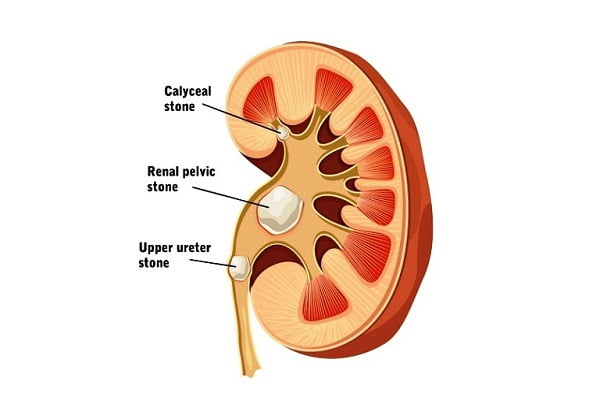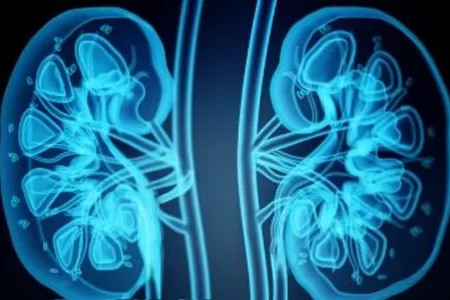What Do Kidney Stones Look Like: Shape, Size, Color and Composition?
- Updated on: Jun 10, 2024
- 5 min Read
- Published on Oct 3, 2019


Kidney stones (Renal Calculi)
Kidneys have the ability to remove toxic and unwanted substances from the body. If concentration of a substance increases in the body, it may lead to an accumulation of the substance in the form of crystals. These crystals are known as kidney stones.
Kidney stones are mainly formed due to dehydration or insufficient water in the body. Kidney stones may be of different sizes, shapes, colors, and compositions. Analysis of these properties of stones in kidneys helps in identifying the cause of kidney stones and allowing preventing stone formation in future.
What do kidney stone look like? Are they small or large in size?
Kidney stones have variable appearances. They may vary with respect to their color, size and shape.
Sizes of kidney stones
The size of kidney stones can range from small sized crystals to large sized stones such as the size of a golf ball. Usually, small-sized stones can easily pass through the urinary tract without any medical assistance. But in some cases, if these stones get struck along the tract, then medical treatment may be required.
Large stones require medical intervention and cannot pass on their own. Certain tests such as KUB, an Ultrasound or an IVP help in determining the size of the stone.
See also: Kidney Stone Pain: How Does It Feel When You Have A Kidney Stone?
See also: Tips for Kidney Stones Pain Relief
Shape of kidney stones
The shape of kidney stones may vary from round, smooth or oval to branched, rough and jagged. They may take shapes of either starbursts, branch-like fingers or could be multi-layered. The shape of kidney stones depends upon the region where they are formed and their composition.
Color of kidney stones: What color are kidney stones
Most of the kidney stones appear either yellow or brown, but some may be black, gold or tan colored. Black kidney stones are generally common. The color of kidney stones depends upon their composition. For example, in case of stones made of calcium whewellite, the stone would have a black or brown color. If the stone consists of magnesium and calcium, then it may appear light yellow in color.
Composition of kidney stones: What are kidney stones made of?
Kidney stones have a variable composition as follows:
Calcium stones
Calcium stones are the most common type of stones found in human kidneys. It has been observed that about 70-80% of stones are made up of calcium oxalate which is black or brown in color and appears as envelope microscopically. This the reason why black kidney stones are relatively common.
Calcium oxalate stones are formed due to excessive oxalate in the urine. About 5-10% stones are made up of calcium phosphate and are white in color. They are formed due to hyperparathyroidism or renal tubular acidosis (increased acid in kidneys).
Uric acid stones
Uric acid stones are comparatively less common than calcium stones, but are commonly found in men as compared to females. They are formed when the acidic content in the urine is very high and it becomes difficult to dissolve the acid in urine, which results in formation of the stones. About 10% of the kidney stones are made up of uric acid. These are soft, smooth and have a diamond shape. They are usually brown in color.
Cystine Stones
Cystine stones are the rarest kind of stones that are found in kidneys. About 1-2% of kidney stones are of this type.
Cystine is an amino acid and is involved in body building. These stones are usually found in people suffering from Cystinuria, which is a genetic disorder. Patient with these types of stones have large amount of cystine in their urine. They are quite difficult to treat and also require a life-long therapy. These stones appear as crystals rather than stones and are usually yellow in color.
Struvite Stone
Struvite stones are formed due to infections in the urinary tract. They mainly consist of magnesium and ammonia. They are horn-shaped, white-colored, and quite large in size. About 10% of the kidney stones are made up of struvite.
In some cases, it has been observed that a person might have stones of different composition in their kidneys. This can be due to patient’s history, diet and his/her kidney functioning.
More: Tips To Dissolve Kidney Stones Naturally: What Helps Pass Kidney Stones?
How do stones look like once they are passed out of kidneys?
Once the kidney stones are removed, they may appear as small pieces or may be unbroken when observed for example in the toilet. Size of a kidney stone may vary. In many cases, kidney stones break down to small pieces which allow them to pass easily through the urinary tract.
See also: Passing of Kidney Stones.
What is the largest kidney stone a person can pass?
Physicians at the Delaware Urological Associates believe that kidney stones larger than 1 cm can pass through the kidneys easily without any medical help. Stones of width less than 3mm can also pass through the kidneys with the help of some home remedies such as increased fluid intake and dietary changes.
Stones of less than 8mm in width have 20% chances to pass through the kidneys spontaneously, over a year. Whereas, stones of more than 8mm in size cause blockage of urinary tract and bleeding occurs during urination.
Large size stones are usually broken into small pieces by lithotripsy, so they can easily pass through the kidneys without any blockage. Therefore, stones of size 8mm are usually considered to be the largest that can pass through the kidneys without any medical intervention.
FAQs
What does a black kidney stone mean?
A black kidney stone is usually an indication of the presence of calcium oxalate or uric acid in the urinary tract. It is important to consult a doctor for diagnosis and treatment as black kidney stones can cause pain and discomfort.
What are black kidney stones made of?
Black kidney stones are usually made of calcium oxalate or uric acid. These substances can accumulate in the kidneys and form stones that can block the urinary tract.
What type of kidney stone is dark?
The most common type of dark kidney stone is the calcium oxalate stone. This type of stone is formed when calcium and oxalate combine in the urine to form crystals.
What foods cause black kidney stones?
Foods that are high in oxalate can contribute to the formation of black kidney stones. Examples of such foods include spinach, rhubarb, beets, and chocolate. It is important to note that other factors, such as dehydration, can also contribute to kidney stone formation.
Are calcium oxalate stones black?
Calcium oxalate stones can appear black, although they can also be brown or tan. The color of the stone can depend on various factors, such as the concentration of minerals and the length of time the stone has been in the urinary tract.
What are black stones in urine?
Black stones in urine can be a sign of the presence of kidney stones or other medical conditions. It is important to consult a doctor for proper diagnosis and treatment.
What foods to avoid if you have calcium oxalate kidney stones?
If you have calcium oxalate kidney stones, it is recommended to avoid foods that are high in oxalate, such as spinach, rhubarb, beets, and chocolate. Other foods to avoid include nuts, tea, and certain types of berries.
How to dissolve calcium oxalate kidney stones naturally?
There are various natural remedies that can help dissolve calcium oxalate kidney stones. These include drinking plenty of water, consuming apple cider vinegar, and eating foods that are high in citric acid, such as lemons and oranges. However, it is important to consult a doctor before trying any natural remedies to dissolve kidney stones.












